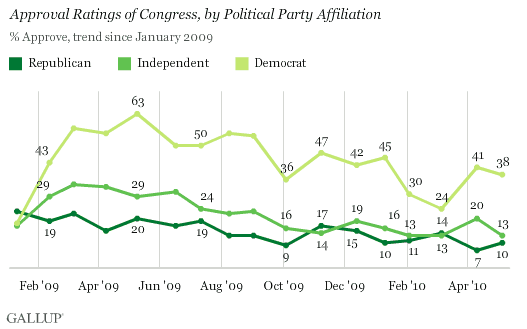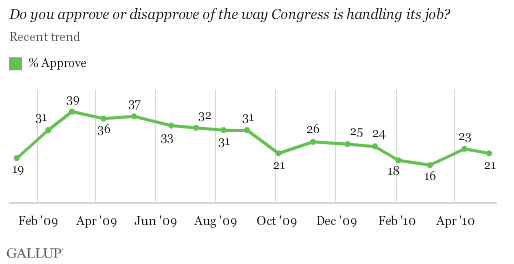WASHINGTON, D.C. -- Democrats continue to rate Congress more favorably than before it passed healthcare reform, but independents' ratings have retreated to their pre-healthcare low of 13%. Democrats and Republicans are relatively steady compared with last month, at 38% and 10%, respectively.

Taken together, Congress is hanging on to most of the approval bump it enjoyed after the approval of healthcare reform, with approval among all Americans down marginally to 21% in May from 23% in April. Nonetheless, its job approval ratings trail most of last year and remain perilous for incumbents with just six months until Election Day.

Since the passage of healthcare reform, Congress has been debating its next big priority, while also considering implications for the midterm elections. Another Gallup poll in April found that Democrats want Congress to prioritize financial reform, while independents and Republicans would prefer that Congress focus on immigration reform.
Implications
Approval of Congress is one of several indicators key to monitoring the political landscape leading up to the congressional midterm elections. Gallup analysis of historical data suggests that the party in control of Congress generally loses a relatively greater proportion of seats when approval is below 40% -- a number this Congress is yet to hit. As a point of reference, 26% of Americans approved of Congress in November 2006, just before control shifted from Republicans to Democrats, and 23% approved in October 1994, just before control shifted from Democrats to Republicans.
Gallup Daily tracking of registered voters' generic ballot preferences has found an even split for the past three weeks in voters' preference between the Republican and Democratic candidate in their district. Democrats and Republicans were tied 46% to 46% in the May 3-6 aggregate, with independents favoring Republicans to Democrats 44% to 38%.
Results are based on telephone interviews with 1,029 national adults, aged 18 and older, conducted May 3-6, 2010. For results based on the total sample of national adults, one can say with 95% confidence that the maximum margin of sampling error is ±4 percentage points.
Interviews are conducted with respondents on landline telephones (for respondents with a landline telephone) and cellular phones (for respondents who are cell phone only).
In addition to sampling error, question wording and practical difficulties in conducting surveys can introduce error or bias into the findings of public opinion polls.
